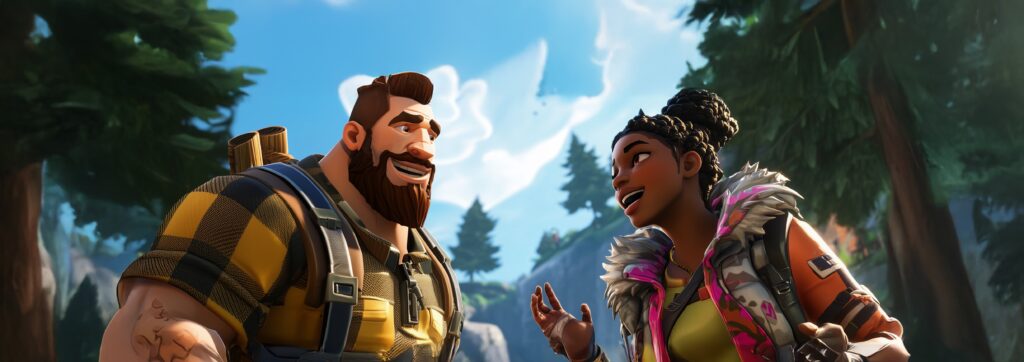30 May 2024
Fortnite’s Ecosystem Hits a YouTube Moment, a Year After Epic’s Revamp
In 2024, brands and creators are jumping into the Fortnite ecosystem with both feet, bringing with them a wave of new agencies and studios intended to facilitate the relationship between the two. Observers of the space see parallels to the early days of other creator platforms such as YouTube.
It’s been just over a year since Epic Games revamped the ecosystem of “Fortnite,” a popular video game that allows users to design and publish their own virtual worlds. The updates included the launch of Unreal Editor for Fortnite (UEFN), a tool that allows users to publish Unreal Engine creations directly inside Fortnite’s Creative mode, and the introduction of a new in-game economy giving in-game creators a 40 percent cut of all “Fortnite” net revenue.
Over the past year, Epic’s updates to the Fortnite ecosystem have sparked an influx of interest from digital creators into the platform, who have brought with them both their communities and the marketing dollars of the brands looking to reach them.
The numbers speak for themselves. In the first year of its new creator economy, Epic paid out over $320 million to participating creators, with some individual users reaping millions from the revenue share. At the moment, total playtime within “Fortnite” is split evenly between creator-made game worlds and the game’s older “Battle Royale” mode, with a concurrent player count that almost never dips beneath one million and peaked at over 11 million earlier this year.
As more gamers and their eyeballs spend time inside the Fortnite ecosystem, marketers are taking advantage. In spite of Epic Games CEO Tim Sweeney’s professed distaste for advertising in his products, “Fortnite” has become a playground for brands trying to reach gamers and Gen Z at scale — largely without any direct involvement from Epic itself. Instead, they are partnering directly with creators, paying them tens of thousands of dollars to both develop customized branded experiences and integrate brands into their pre-existing virtual worlds.
YouTube’s now-robust creator economy developed organically over the years, with the website’s early low-budget video creators gradually giving way to today’s professionalized content studios, with sales teams and content fine-tuned for brands’ marketing dollars. In the Fortnite ecosystem, this evolution is happening much more rapidly and intentionally.
Today, for example, the action camera brand GoPro is sponsoring a Fortnite dodgeball game built and co-owned by the studio Creators Corp., in partnership with the creator collective Dude Perfect. The activation represents a deliberate collaboration between a non-endemic brand and an influencer whose audience matches it — the Fortnite ecosystem equivalent to a brand partnering with a big YouTuber instead of investing in its own YouTube content.
“Fortnite Creative feels very much like YouTube in 2015, in the sense that people are still discovering it, seeing how they could be integrating into it, even in terms of game functions,” said Agatha Bleuzen, managing director of gaming at the agency Cherry Pick Talent, which facilitated the deal. “Once you launch a game on ‘Fortnite,’ it does very well for the first few weeks, and after that it kind of starts dying down, just like on social platforms. That’s why studios can bring new updates into the game for people to be excited about — it works in a very similar way.”
Creators’ approach to the Fortnite ecosystem is also evolving to follow the money. Gaming influencers such as Andre “Typical Gamer” Rebelo have invested millions of dollars into the formation of their own studios, such as Rebelo’s JOGO, which launched last week with a portfolio of monetizable in-game experiences. Rebelo’s pre-existing network of Fortnite games has already earned the influencer over $5 million in shared revenue, he told Digiday.
“We’ve been covertly out for a year now, and we have nearly 200 million plays,” Rebelo said. “We have over 50 million unique players that have played our maps, which is insane to think about.”
The evolution of the Fortnite ecosystem into a platform for creators to make a living — and brands to spend their marketing dollars — is a reflection of both the explosion of gaming as an entertainment channel and the thinning of the distinction between games and social media as gaming companies such as Roblox look to attain full-on platform status. Fortnite is quickly transforming from a video game into a place for consumers to live their lives, and brands are at the forefront of that shift.
“Social and gaming want the same thing, which is attention,” said Gareth Leeding, global chief strategy officer for gaming marketing specialists Livewire. “The difference is, social is pulling through dopamine-driven content, whereas gaming is all through experience and immersive experience — and, actually, there’s a really big difference between those two things.”
The Trials And Tribulations Of Running A UGC Studio
Roblox and Fortnite are in a race to become the biggest game creation platforms in the world, and creators are…
The Dichotomy Of Fortnite Creative Updates
Fortnite Creative is like a living space—it needs ongoing care and maintenance to remain welcoming for both players and creators….

